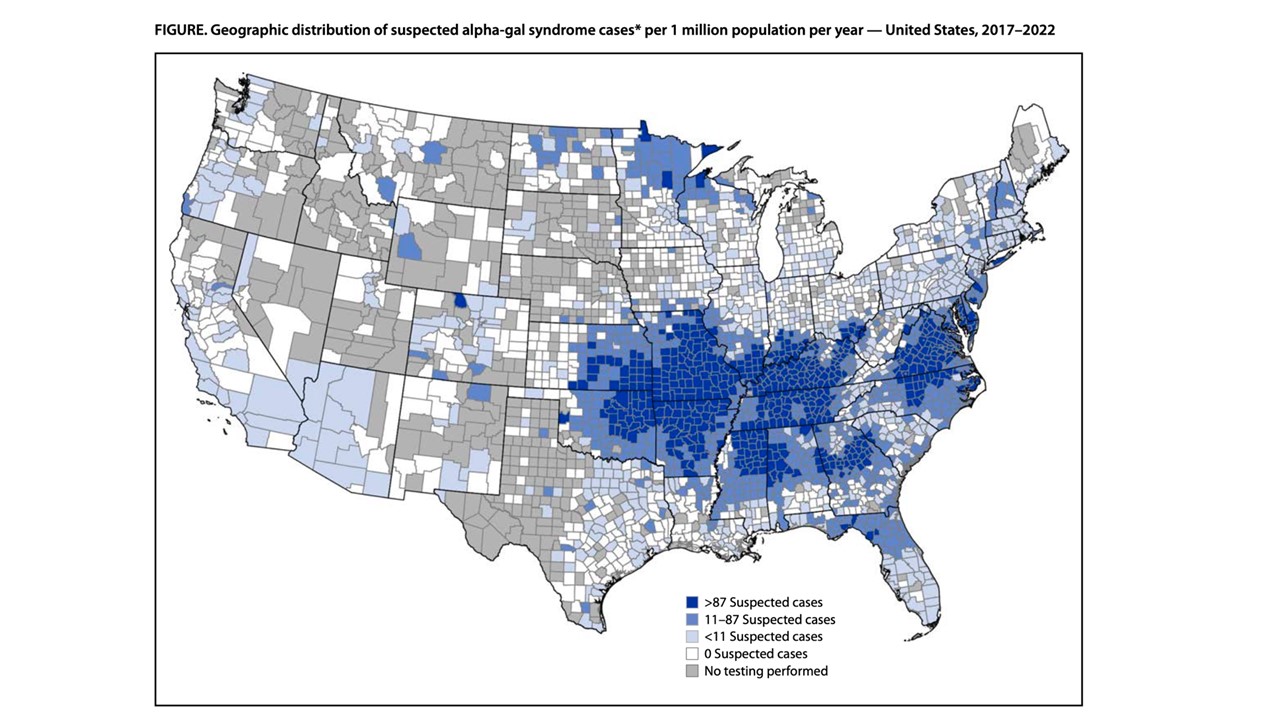TOXICOLOGY QUESTION OF THE WEEK
August 18, 2023
What is the distribution of Alpha-gal allergy in the United States?
In May 2016, the Question of the Week reported on tickborne-related alpha-gal allergies and the subsequent mammalian meat allergies that occur. Alpha gal is the abbreviation for galactose-alpha-1,3 galactose (Alpha-gal). It is found in most mammalian tissue and mammalian-derived products such as dairy products. Sensitivity to this oligosaccharide may result in IgE-mediated hypersensitivity that may vary from urticaria to anaphylaxis. Humans typically make IgE antibodies to epitopes on proteins, but this is a carbohydrate. Alpha-gal is associated with bites from the Lone Star tick. The hypersensitivity to alpha-gal may present in a delayed fashion e.g. hours after ingestion of the meat source.
A study recently published in MMWR examined the alpha-gal specific IgE antibody testing that was performed in the United States during 2017-2022. There is one laboratory that does the majority of testing, so the samples would be representative of the prevalence of the IgE antibody. Interestingly, the IgE was more commonly positive in older patients. More women were tested, but more men were likely to be positive.
The Figure below was published in the MMWR 2023 study.1

There is concern that the geographic range of the lone star tick will expand, and alpha-gal allergies will become more prevalent.
A few pearls:
Those patients who are allergic to alpha-gal may also be allergic to bovine or porcine related gelatins. Gelatin exposure can be difficult to discern as some products such as processed foods and confectionaries may have unrecognized gelatin in them. Also, both MMR and varicella vaccines have gelatin that may cause allergic reactions.2
Crotalidae Polyvalent, Immune Fab (ovine) [CroFab®] contains alpha-gal, which may be a source of reactions to the antivenom. One article noted that alpha-gal antigen is present in the Fab antivenom and may account for increased reactions to the Fab fragment where the Lone Star tick resides versus locations where the lone star tick is not endemic.3
REFERENCES
1. Thompson JM et al. Geographic distribution of suspected alpha-gal syndrome cases-United States, Jan 2017-December 2022. MMWR 2023;72:815-82.
2. Stone, CA et al. Anaphylaxis after vaccination in a pediatric patient: further implicating alpha-gal-allergy. J Allergy Clin Immunol Pract 2019;7:322-324.
3. Straesser M, et al. alpha-gal on crotalidae-polyvalent antivenom (Cro Fab) : investigating the relevance to immediate hypersensitivity reactions. J Allergy Clin Immunol Pract 2021;9:1015-1017.
Question submitted by Saralyn Williams MD, Professor of Emergency Medicine, Medicine, and Pediatrics VUMC.
I am interested in any questions you would like addressed in the Question of the Week. Please email me with any suggestions at donna.seger@vumc.org.
DONNA SEGER, MD
Professor Emeritus
Department of Medicine
VUMC
|
|
TENNESSEE POISON CENTER 24/7 FREE MEDICAL HOTLINE
POISON HELP | 800.222.1222 |